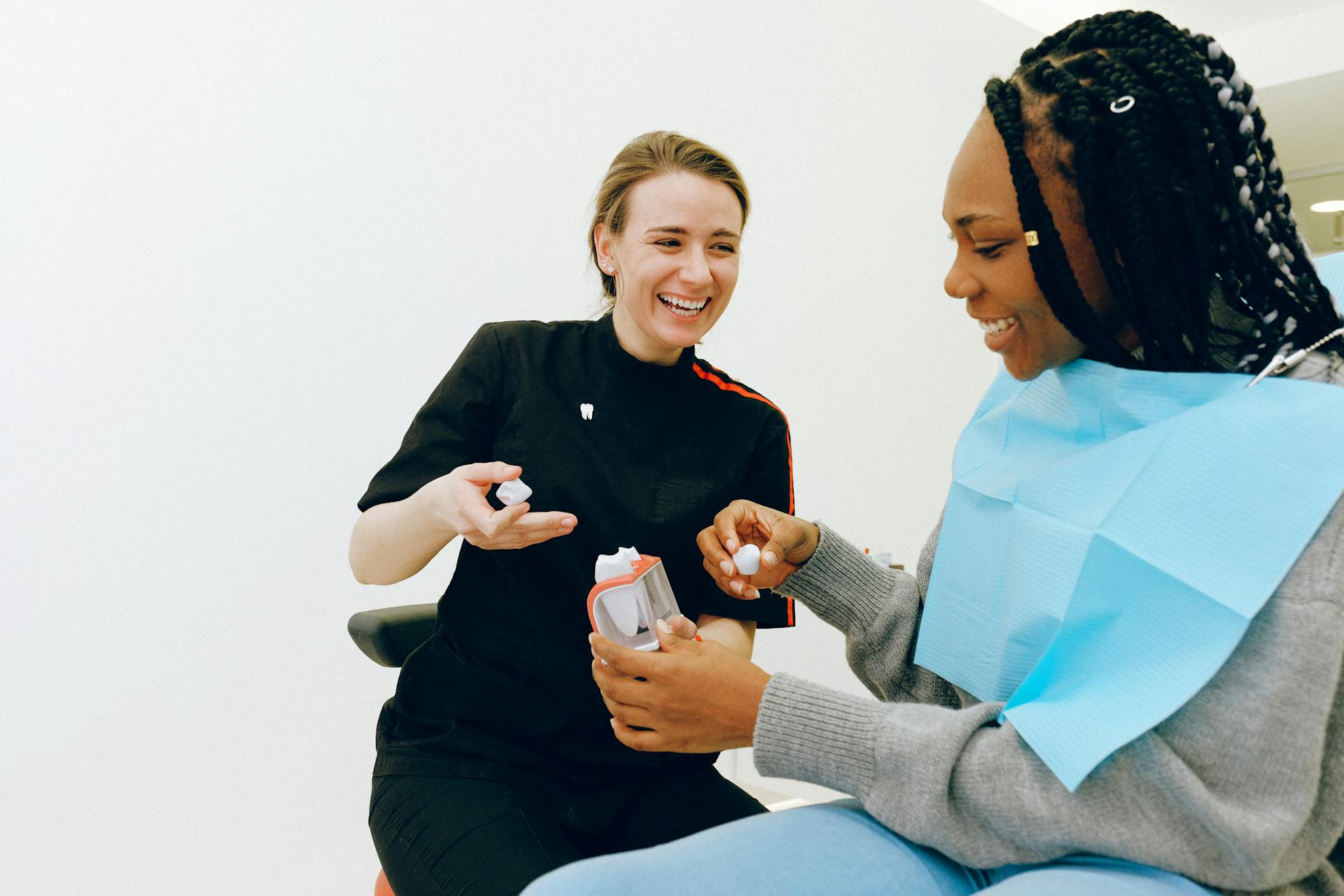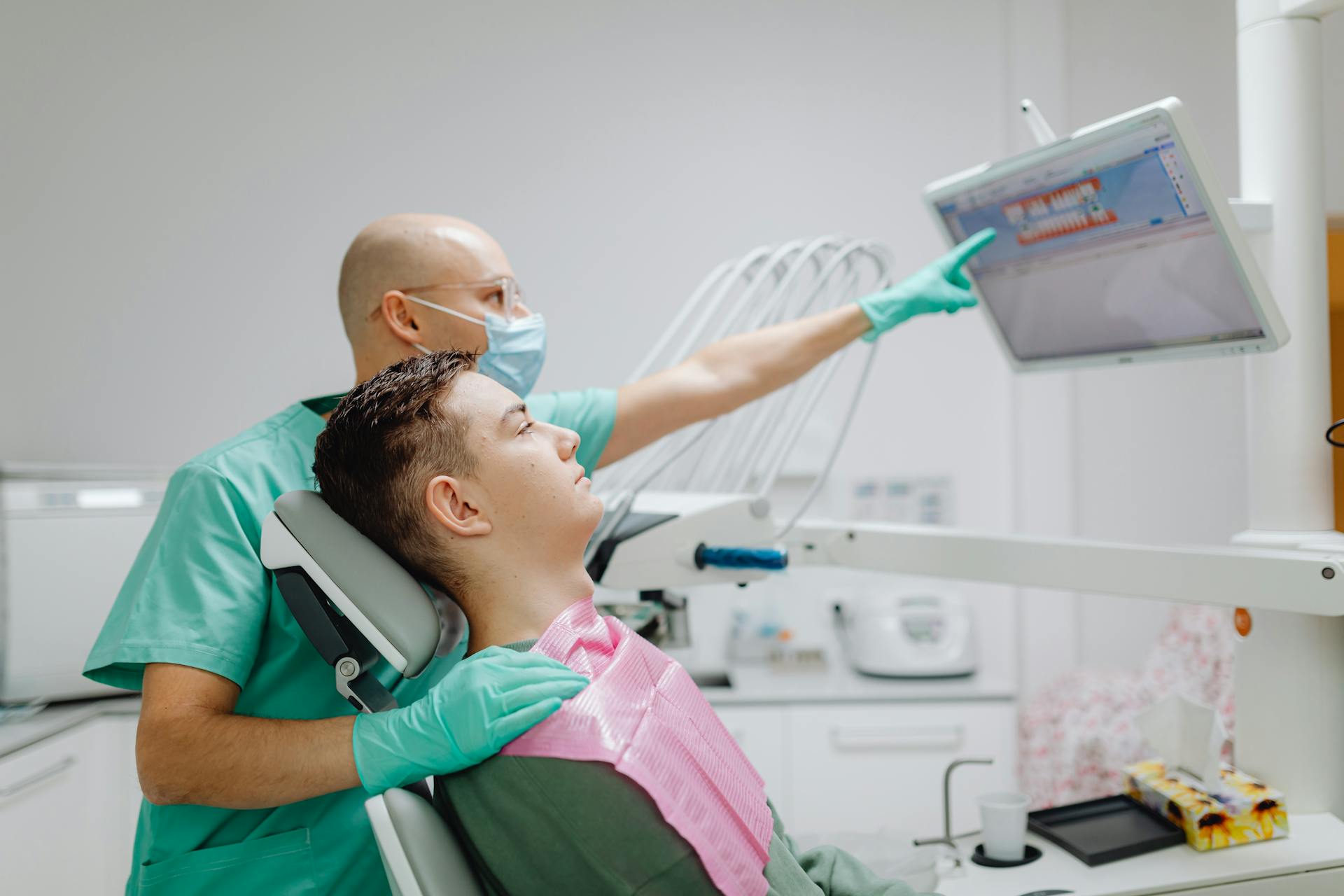
If you're one of the many Americans without dental insurance, you're not alone. Approximately 27% of adults in the United States have no dental insurance.
You may be surprised to learn that many dentists offer in-office financing options to help make dental care more affordable. These plans can be interest-free or low-interest, and some even allow you to pay off your balance over time.
Some people have found success with dental discount plans, which can offer significant savings on dental care services. These plans typically cost between $80 and $150 per year and can provide discounts of up to 60% on dental procedures.
For your interest: Health and Dental Insurance Texas
Dental Insurance Alternatives
Dental Savings Plans can be a viable alternative to traditional dental insurance. You can get a discount of 10% to 60% off services from dentists who are in the plan's network.
These plans typically work by charging a yearly fee, which is often less than $150 for a family, and there's no deductible. This means you can use the discount within a few days of signing up, making it a great option if you need work done soon.
Curious to learn more? Check out: Prepaid Dental Insurance Plans
Some companies offer dental savings plans as part of their employee benefits package, or you can find them through groups and associations, as well as directly from major insurance companies. Thousands of dentists take part in these plans, and you can usually get a member list from the plan's sponsor.
You can also ask your dentist if they take part in a plan and how much you could save with it. If you're open to new providers, call a few who are in the plan you're thinking about to see if the savings would be worth it.
Here are some pros and cons of dental savings plans to consider:
- May help you save money.
- No waiting period for dental services.
- No paperwork.
- You have a wide choice of dentists to choose from.
- Discounts on a range of dental procedures.
- Additional “lifestyle” benefits, such as identity protection, roadside assistance, and wellness programs.
- You can also buy a discount dental program in addition to traditional dental insurance.
But, keep in mind that "discount" doesn't mean free, and you'll still pay an annual membership fee. Each dental service you receive may cost you out-of-pocket, even if it comes with a discount.
Discount Programs
Discount programs offer a convenient alternative to traditional dental insurance. They're often referred to as dental savings plans or discount dental programs.
You can save 10% to 60% off services from dentists who are part of the plan's network with a yearly fee that's typically less than $150 for a family.
The plans usually have no deductible, meaning you don't have to pay a certain amount before the discount kicks in. You can even use the discount within a few days of signing up, making it a great option if you need immediate dental work.
Dental savings plans may be a good option for people who don't have access to dental insurance or want services that aren't covered by insurance, such as teeth whitening.
If you need dental work that costs more than your dental insurance will pay, a discount program can help you save money. For example, saving 50% on a couple of root canals that cost $1,000 each can add up quickly.
To find a dental savings plan, you can ask your dentist if they participate in one and how much you could save. You can also check with the Better Business Bureau or your state's insurance regulator to see if a company has had complaints made against it.
Check this out: Individual Dental Insurance Plans Ppo
Some reputable companies offer dental savings plans, but be cautious of scams and high-pressure salespeople. Always ask to be mailed information before making a payment.
Here are some benefits of dental savings plans:
- May help you save money
- No waiting period for dental services
- No paperwork
- Wide choice of dentists to choose from
- Discounts on a range of dental procedures
- Additional "lifestyle" benefits, such as identity protection and wellness programs
Public Clinics
Public clinics are a great option for affordable dental care. Many of these clinics charge low, fixed prices or sliding fees based on how much you can afford.
You can find public clinics run by local or state health departments or by community health centers that get grants from the federal government. Some clinics offer exams, cleanings, X-rays, root canals, fillings, crowns, and surgical tooth extractions.
A full set of X-rays for kids can cost as little as $15 at some clinics. You can search for clinics on the website Toothwisdom.org, which is run by the nonprofit group Oral Health America.
Toothwisdom.org has a national directory of affordable dental programs, including public clinics. This can be a huge help if you're looking for a clinic in your area.
Some public clinics may have emergency dentists on call, so it's worth checking ahead of time to see what services they offer.
Recommended read: Can You Get Dental Insurance without Medical Insurance
Pros and Cons

Dental insurance alternatives like dental savings plans can be a cost-effective option, with prices starting at around $80 per year for individuals and $200 per year for families.
These plans often have no annual maximum, so you can save up to 60% on dental care costs.
They also usually don't require you to choose a specific dentist, giving you more flexibility in your care.
However, some plans may have limited coverage for certain procedures, such as orthodontics or cosmetic dentistry.
You'll also need to pay out-of-pocket for services not covered by the plan.
Many people find that the savings and flexibility make these plans a great alternative to traditional dental insurance.
Schools
If you're looking for affordable dental care, you can explore dental schools in your state. Every state has at least two dental or dental hygiene programs.
Alaska has four dental programs, which is a notable exception. New York has 160, making it one of the states with the most programs.
You can search the website for the Commission on Dental Accreditation to find a school in your state.
Understanding Dental Insurance
It's essential to understand the basics of dental insurance before considering alternatives. Dental savings plans can be a viable option, but it's crucial to be aware of their pros and cons.
Dental savings plans can provide significant cost savings, but they may not offer the same level of coverage as traditional dental plans. You should ask yourself if you're willing to pay out-of-pocket for certain services to take advantage of lower premiums.
Consider your situation and needs carefully when deciding between a discount dental program and traditional dental coverage.
Are They Worth It?
Dental savings plans can be a viable alternative to traditional dental insurance, but it's essential to weigh the pros and cons before making a decision.
Discount dental plans can offer significant savings on dental care, with some plans reducing costs by as much as 60% compared to paying out-of-pocket.
To determine if a dental savings plan is worth the money, consider your individual needs and budget.
A discount dental plan may be a good option if you're looking for a more affordable way to pay for routine dental care, such as cleanings and check-ups.
However, if you have complex dental needs or require specialized procedures, a traditional dental insurance plan may be a better fit.
Ultimately, the decision to invest in a dental savings plan depends on your unique circumstances and priorities.
Is Different
DentalSave operates on a different model than traditional orthodontic insurance.
Instead of paying a premium, you purchase a membership fee that entitles you to 25 percent discounts on any care you receive from participating dentists.
You pay discounted rates directly to the dentist, but there’s no annual cap—you save money on all the care you need.
That’s especially important with expensive treatments like orthodontics.
DentalSave memberships start at $99 a year for an individual, or $199 for a family or three or more.
This can be a more cost-effective option, especially if you're looking for a way to save on orthodontic care.
Suggestion: Blue Care Dental Insurance
Preventive: A Must-Have Benefit
Preventive dental care is a must-have benefit, not a nice-to-have. Over 2 million emergency department visits in 2018 were due to dental pain, averaging $749 per nonhospitalized patient.
Emergency room visits for dental pain can be extremely costly, far exceeding the cost of a routine dental visit. The short-term cost of an emergency room bill can be staggering.
Regular dental care visits check for cavities, periodontal disease, and abscesses, but also examine patients for signs of oral cancer, imminent tooth loss, and other severe conditions.
Dental care is health care, linked to serious conditions like Alzheimer's disease and diabetes. Regular dental care prevents infections, cavities, and other oral issues that start small but can grow into serious health problems.
The cost of an emergency room visit for dental pain far exceeds the cost of a routine dental visit, making preventive care a crucial investment in your overall health.
You might like: Is Dental Insurance Considered Health Insurance for Tax Purposes
Government Coverage
Government coverage can be a lifesaver for those in need of dental care, especially for low-income families. If you earn very little or are unemployed, you may be eligible for Medicaid or the Children's Health Insurance Program (CHIP).
Medicaid charges no monthly premiums in most states, which is a huge relief for those who can't afford it. It covers dental care in full for children up to age 19.
About one-third of states offer limited dental benefits for adults, while another third cover extensive dental treatments.
California Dental Insurance
California has some great dental insurance options. Delta Dental offers up to $2,000 annual max with a large network of dentists. Spirit Dental has no waiting period and up to $5,000 annual max.
Low premiums and copays can be found with California Dental, and they even offer no deductibles. Cigna Dental has a nationwide network and affordable prices, with up to $1,500 annual maximum.
In-network savings can make a big difference, with Spirit Dental plans offering 33.6% average network discount for root canals and 31.8% for dental implants.
Curious to learn more? Check out: Dental Insurance Ppo California
California Carriers
California Carriers offer a range of benefits, but some stand out for their unique features. Delta Dental is one of the top carriers available in California, offering orthodontic coverage and an annual maximum of up to $2,000.
Spirit Dental is another popular option, with no waiting period and an annual maximum of up to $5,000. This makes it a great choice for those who need immediate coverage or have more complex dental needs.
California Dental plans are known for their low premiums and copays, with some even offering no deductibles. This can be a huge cost-saver for those on a tight budget.
Cigna Dental is a well-established carrier with a nationwide network, offering an annual maximum of up to $1,500. This makes it a great option for those who travel frequently or need to see specialists.
If you're looking for a plan with in-network savings, Spirit Dental is a great choice. Their Network Spirit plans offer discounted rates for in-network procedures, which can help you save big on dental care.
California In-Network
Choosing a California dental insurance plan with in-network savings can be a game-changer for your wallet. By opting for a PPO plan, you'll get discounted rates from participating dentists.
In-network savings can make a big difference in the cost of procedures. For example, the average cost of a dental crown in California is $1,205.07, but with a Network plan, you can save 36.1% on that.
Dental implants are another area where in-network savings can help. The average cost of a dental implant in California is $4,904.84, but with a Network plan, you can save 31.8%.
Root canals are also a common procedure that can benefit from in-network savings. The average cost of a root canal in California is $1,046.52, and with a Network plan, you can save 33.6%.
Even routine check-ups can be more affordable with in-network savings. The average cost of a check-up in California is $249.74, and with a Network plan, you can save on every aspect of your visit.
Frequently Asked Questions
How to take care of your teeth if you don't have dental insurance?
Consider affordable options like payment plans, dental schools, community health centers, and discount plans to access quality dental care without insurance
How can I fix my teeth if I don't have money?
Get affordable dental care at local clinics, such as dental schools or Federally Qualified Health Centers (FQHCs), which offer sliding scale fees based on income
Sources
- https://www.cigna.com/knowledge-center/discount-dental-programs
- https://directbenefits.com/california-dental-insurance
- https://www.webmd.com/health-insurance/uninsured-free-low-cost-dental
- https://dentalsave.com/lp/dental-insurance/orthodontic-insurance/
- https://www.drbicuspid.com/dental-practice/office-management/insurance/article/15546466/dental-savings-plans-are-an-alternative-to-dental-insurance
Featured Images: pexels.com


